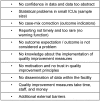Quality indicators in intensive care medicine for Germany - third edition 2017
- PMID: 28794694
- PMCID: PMC5541336
- DOI: 10.3205/000251
Quality indicators in intensive care medicine for Germany - third edition 2017
Abstract
Quality improvement in medicine is depending on measurement of relevant quality indicators. The quality indicators for intensive care medicine of the German Interdisciplinary Society of Intensive Care Medicine (DIVI) from the year 2013 underwent a scheduled evaluation after three years. There were major changes in several indicators but also some indicators were changed only minimally. The focus on treatment processes like ward rounds, management of analgesia and sedation, mechanical ventilation and weaning, as well as the number of 10 indicators were not changed. Most topics remained except for early mobilization which was introduced instead of hypothermia following resuscitation. Infection prevention was added as an outcome indicator. These quality indicators are used in the peer review in intensive care, a method endorsed by the DIVI. A validity period of three years is planned for the quality indicators.
Qualitätsverbesserung in der Medizin hängt von der Messung relevanter Qualitätsindikatoren ab. Die Qualitätsindikatoren für die Intensivmedizin der Deutschen Interdisziplinären Vereinigung für Intensivmedizin (DIVI) aus dem Jahre 2013 sind nun planmäßig nach drei Jahren überarbeitet und angepasst worden. Hierbei gab es deutliche Änderungen in einigen Indikatoren während einige nur minimal verändert wurden. Der Fokus auf intensivmedizinische Behandlungsprozesse wie interprofessionelle Visiten, Management von Analgesie und Sedierung, Beatmung und Weaning blieb ebenso bestehen wie die Gesamtzahl von 10 Indikatoren. Die Themenschwerpunkte blieben weitgehend bestehen außer der Frühmobilisation, welche anstatt der Hypothermie nach Reanimation eingeführt wurde. Infektionsprävention wurde als Ergebnisindikator hinzugefügt. Diese Qualitätsindikatoren werden im Peer Review Prozess der DIVI eingesetzt. Eine Gültigkeitsdauer von drei Jahren ist für diese Qualitätsindikatoren geplant.
Keywords: intensive care medicine; peer review; quality indicators; quality management.
Conflict of interest statement
The authors declare that they have no competing interests regarding the content of this manuscript.
Figures


References
-
- Braun JP, Mende H, Bause H, Bloos F, Geldner G, Kastrup M, Kuhlen R, Markewitz A, Martin J, Quintel M, Steinmeier-Bauer K, Waydhas C, Spies C NeQuI (quality network in intensive care medicine) Quality indicators in intensive care medicine: why? Use or burden for the intensivist. GMS Ger Med Sci. 2010;8:Doc22. doi: 10.3205/000111. Available from: http://dx.doi.org/10.3205/000111. - DOI - DOI - PMC - PubMed
-
- Braun JP, Kumpf O, Deja M, Brinkmann A, Marx G, Bloos F, Kaltwasser A, Dubb R, Muhl E, Greim C, Bause H, Weiler N, Chop I, Waydhas C, Spies C. The German quality indicators in intensive care medicine 2013 – second edition. GMS Ger Med Sci. 2013;11:Doc09. doi: 10.3205/000177. Available from: http://dx.doi.org/10.3205/000177. - DOI - DOI - PMC - PubMed
-
- Kumpf O, Bloos F, Bause H, Brinkmann A, Deja M, Marx G, Kaltwasser A, Dubb R, Muhl E, Greim CA, Weiler N, Chop I, Jonitz G, Schaefer H, Felsenstein M, Liebeskind U, Leffmann C, Jungbluth A, Waydhas C, Pronovost P, Spies C, Braun JP Netzwerk Qualität in der Intensivmedizin (NeQuI) Voluntary peer review as innovative tool for quality improvement in the intensive care unit – a retrospective descriptive cohort study in German intensive care units. GMS Ger Med Sci. 2014;12:Doc17. doi: 10.3205/000202. Available from: http://dx.doi.org/10.3205/000202. - DOI - DOI - PMC - PubMed
-
- Braun JP, Bause H, Bloos F, Geldner G, Kastrup M, Kuhlen R, Markewitz A, Martin J, Mende H, Quintel M, Steinmeier-Bauer K, Waydhas C, Spies C NeQuI (quality network in intensive care medicine) Peer reviewing critical care: a pragmatic approach to quality management. GMS Ger Med Sci. 2010 Oct 8;8:Doc23. doi: 10.3205/000112. Available from: http://dx.doi.org/10.3205/000112. - DOI - DOI - PMC - PubMed
-
- Brinkmann A, Genz R, Köberer A, Fuchs T, Weber R, Dubb R, et al. Dialog auf Augenhöhe. f&w - Führen und Wirtschaften im Krankenhaus. 2013;30:598–601.

